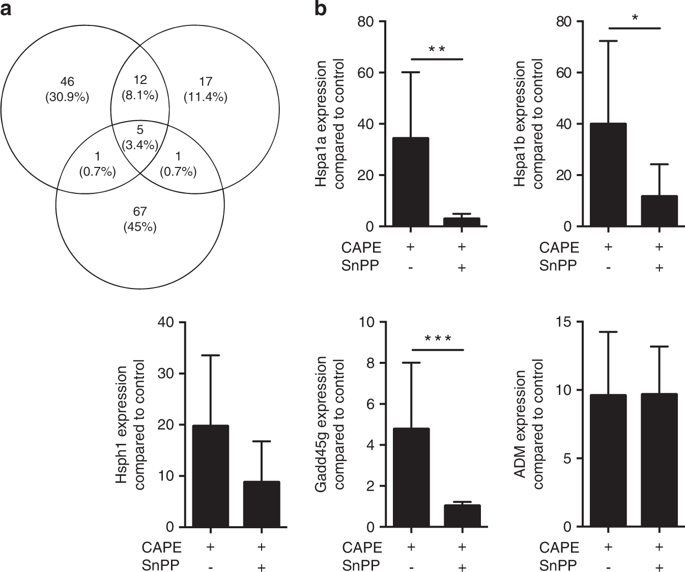当前位置:
X-MOL 学术
›
Int. J. Oral Sci.
›
论文详情
Our official English website, www.x-mol.net, welcomes your
feedback! (Note: you will need to create a separate account there.)
Caffeic acid phenethyl ester protects against oxidative stress and dampens inflammation via heme oxygenase 1.
International Journal of Oral Science ( IF 10.8 ) Pub Date : 2019-02-20 , DOI: 10.1038/s41368-018-0039-5 Alexandra Stähli 1, 2 , Ceeneena Ubaidha Maheen 1 , Franz Josef Strauss 1, 3 , Sigrun Eick 2 , Anton Sculean 2 , Reinhard Gruber 1, 2, 4
International Journal of Oral Science ( IF 10.8 ) Pub Date : 2019-02-20 , DOI: 10.1038/s41368-018-0039-5 Alexandra Stähli 1, 2 , Ceeneena Ubaidha Maheen 1 , Franz Josef Strauss 1, 3 , Sigrun Eick 2 , Anton Sculean 2 , Reinhard Gruber 1, 2, 4
Affiliation

|
Periodontal disease is associated with chronic oxidative stress and inflammation. Caffeic acid phenethyl ester (CAPE), which is a potent inducer of heme oxygenase 1 (HO1), is a central active component of propolis, and the application of propolis improves periodontal status in diabetic patients. Here, primary murine macrophages were exposed to CAPE. Target gene expression was assessed by whole-genome microarray, RT-PCR and Western blotting. The antioxidative and anti-inflammatory activities of CAPE were examined by exposure of the cells to hydrogen peroxide, saliva and periodontal pathogens. The involvement of HO1 was investigated with the HO1 inhibitor tin protoporphyrin (SnPP) and knockout mice for Nrf2, which is a transcription factor for detoxifying enzymes. CAPE increased HO1 and other heat shock proteins in murine macrophages. A p38 MAPK inhibitor and Nrf2 knockout attenuated CAPE-induced HO1 expression in macrophages. CAPE exerted strong antioxidative activity. Additionally, CAPE reduced the inflammatory response to saliva and periodontal pathogens. Blocking HO1 decreased the antioxidative activity and attenuated the anti-inflammatory activity of CAPE. In conclusion, CAPE exerted its antioxidative effects through the Nrf2-mediated HO1 pathway and its anti-inflammatory effects through NF-κB inhibition. However, preclinical models evaluating the use of CAPE in periodontal inflammation are necessary in future studies.
中文翻译:

咖啡酸苯乙酯可通过血红素加氧酶1抵抗氧化应激并减轻炎症。
牙周疾病与慢性氧化应激和炎症有关。咖啡酸苯乙酯(CAPE)是血红素加氧酶1(HO1)的有效诱导剂,是蜂胶的主要活性成分,蜂胶的应用可改善糖尿病患者的牙周状况。在这里,原代鼠巨噬细胞暴露于CAPE。通过全基因组微阵列,RT-PCR和蛋白质印迹评估靶基因的表达。通过使细胞暴露于过氧化氢,唾液和牙周病原体来检查CAPE的抗氧化和抗炎活性。用HO1抑制剂锡原卟啉(SnPP)和敲除小鼠的Nrf2(这是一种解毒酶的转录因子)研究了HO1的参与。CAPE增加了鼠巨噬细胞中的HO1和其他热激蛋白。p38 MAPK抑制剂和Nrf2敲除减弱了巨噬细胞中CAPE诱导的HO1表达。CAPE具有很强的抗氧化活性。此外,CAPE减少了对唾液和牙周病原体的炎症反应。阻断HO1降低了CAPE的抗氧化活性并减弱了其抗炎活性。总之,CAPE通过Nrf2介导的HO1途径发挥其抗氧化作用,并通过抑制NF-κB发挥抗炎作用。但是,在将来的研究中,需要临床前模型来评估CAPE在牙周炎症中的使用。阻断HO1降低了CAPE的抗氧化活性并减弱了其抗炎活性。总之,CAPE通过Nrf2介导的HO1途径发挥其抗氧化作用,并通过抑制NF-κB发挥抗炎作用。但是,在将来的研究中,需要临床前模型来评估CAPE在牙周炎症中的使用。阻断HO1降低了CAPE的抗氧化活性并减弱了其抗炎活性。总之,CAPE通过Nrf2介导的HO1途径发挥其抗氧化作用,并通过抑制NF-κB发挥抗炎作用。但是,在将来的研究中,需要临床前模型来评估CAPE在牙周炎症中的使用。
更新日期:2019-02-20
中文翻译:

咖啡酸苯乙酯可通过血红素加氧酶1抵抗氧化应激并减轻炎症。
牙周疾病与慢性氧化应激和炎症有关。咖啡酸苯乙酯(CAPE)是血红素加氧酶1(HO1)的有效诱导剂,是蜂胶的主要活性成分,蜂胶的应用可改善糖尿病患者的牙周状况。在这里,原代鼠巨噬细胞暴露于CAPE。通过全基因组微阵列,RT-PCR和蛋白质印迹评估靶基因的表达。通过使细胞暴露于过氧化氢,唾液和牙周病原体来检查CAPE的抗氧化和抗炎活性。用HO1抑制剂锡原卟啉(SnPP)和敲除小鼠的Nrf2(这是一种解毒酶的转录因子)研究了HO1的参与。CAPE增加了鼠巨噬细胞中的HO1和其他热激蛋白。p38 MAPK抑制剂和Nrf2敲除减弱了巨噬细胞中CAPE诱导的HO1表达。CAPE具有很强的抗氧化活性。此外,CAPE减少了对唾液和牙周病原体的炎症反应。阻断HO1降低了CAPE的抗氧化活性并减弱了其抗炎活性。总之,CAPE通过Nrf2介导的HO1途径发挥其抗氧化作用,并通过抑制NF-κB发挥抗炎作用。但是,在将来的研究中,需要临床前模型来评估CAPE在牙周炎症中的使用。阻断HO1降低了CAPE的抗氧化活性并减弱了其抗炎活性。总之,CAPE通过Nrf2介导的HO1途径发挥其抗氧化作用,并通过抑制NF-κB发挥抗炎作用。但是,在将来的研究中,需要临床前模型来评估CAPE在牙周炎症中的使用。阻断HO1降低了CAPE的抗氧化活性并减弱了其抗炎活性。总之,CAPE通过Nrf2介导的HO1途径发挥其抗氧化作用,并通过抑制NF-κB发挥抗炎作用。但是,在将来的研究中,需要临床前模型来评估CAPE在牙周炎症中的使用。











































 京公网安备 11010802027423号
京公网安备 11010802027423号